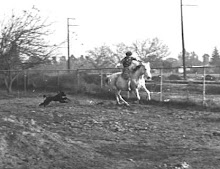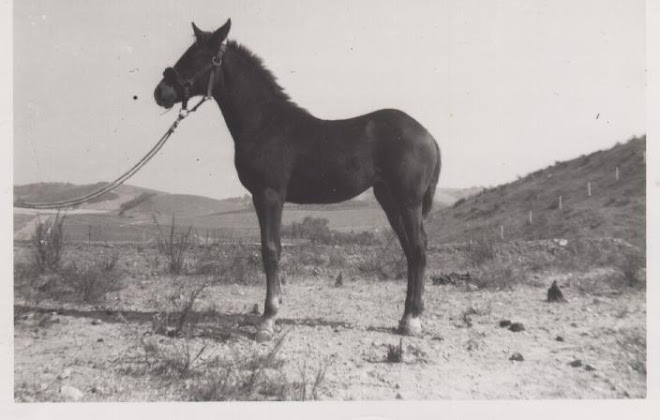Sheba, the Horse With a History
©Ken Harris, 2009
Growing a mane and tail were beyond me, so I set about learning to ride. Sheba taught me, so it is fitting that I start my tale with her. Without Sheba there would have been no Ken and Legend. Well, yes there would have been individually, but not together as the eminently defeatable team we became.
Sheba, a small, refined Arab mare, was a horse with a history. Unfortunately, nobody knew what that history was. We never found out.
Joanne claims she was born to ride horses. She and her older sister, Audrey, spent their summers on the family mining claim on Paiute Mountain in California’s southern Sierra Nevadas. Whenever the two girls found a horse minding its own business in a nearby meadow, they would attempt to catch and ride him. They always let him go. It wasn’t really horse stealing. It was more of a catch-and-release program.
During the winter months the family lived in East Los Angeles and Joanne rented horses from nearby stables with her babysitting money and she worked one summer at a camp as a counselor. She got to ride there.
But it was not quite the same thing as owning her own horse. It wasn’t even close. And so, one day in 1951 when Joanne was 17, her parents moved from East Los Angeles to El Monte, to a nice house on a large lot with a repairable barn and room for a corral for a horse. And Sheba came into her life. Drumroll here.
A friend of a friend of Joanne’s sister, Audrey, had a horse. She (call her Jane Doe) and her husband (but of course, John) were separating, and the horse had to go. Joanne’s mother, Esther, contacted John who told her, “It’s this way. We’re splitting the sheets and the horse has to go. If you will give her a good home, she’s yours.” He would probably have said the same thing about Jane. He might not have even insisted on a good home for her.
John and Jane delivered the horse and Joanne was ecstatic, as only a first-time horse owner can be. Sheba was a small, refined flea-bitten grey mare, 14 hands high, barely enough to qualify as a horse.
A little explanation here. A hand equals four inches. A horse’s height is measured from the ground to the top of his shoulder blades, his withers. If a horse is exactly five feet from ground to wither top, that converts to exactly 60 inches. Sixty divided by four equals 15. Ergo, the horse is said to be 15 hands high. See how simple that is?
Sheba barely qualified for horsehood. She was just 14.2, that is, fourteen hands two inches high. Any equine below that height is a pony. It’s official. It’s a recognized by all the major horse and pony associations.
When I said she was a flea-bitten grey I did not mean she had flea blight. She was a light grey horse with darker flecks of grey. If the darker grey flecks had been larger and less defined, she would have been dappled instead of flea-bitten.
Sheba had one other identifying mark, a scar on her left flank and some muscle missing under it. Something majorly bad had happened to her, but no one ever found out what it was. She had healed and was sound of wind and limb.
Sheba fit into the Heyser family very well. Horses actually like being with kids, if the kids show any competence at all. Kids go interesting places and do interesting things. Adults ride in circles or walk on trails. Sometimes they enter horse show classes and walk, trot, canter and back up. Ooh, and this is exciting, be still my beating heart, sometimes adults go out and stand around in the middle of a show ring attached to their horses with lead lines and nice halters while someone called “the judge” walks around them and makes cryptic comments to someone called “the secretary” who notes them down on her clipboard. Then a few people get ribbons and everyone goes home. No, on the whole, horses would rather be with kids than adults.
Joanne and Sheba used to gymkhana a lot. Gymkhana is a competition for young people involving pole bending (they don’t actually bend the poles, they weave in and out like a slalom), barrel racing (again, they don’t race the barrels, they run around them in tight Celtic knots) and other surprise events.
One such surprise event involved the kids and their horses starting on a line, racing to the other end of the ring, dismounting, lifting up a barrel, trying to grab whatever they found there, get back on their horse again, and ride back to the finish line. Under each barrel was a live chicken. Assuming the kid could grab her chicken, there was not one hope in Hell of ever catching her horse again. As for mounting with a squawking chicken in her hand, forget it! Most of the horses were hysterical but Sheba thought it was a wonderful game called “chicken stomp.” While the other horses were trying to flee, she was trying to nail the birds with her hooves. She couldn’t do it because the chickens were fast and there were just too many of them. But she tried. And she had a wonderful time. Everybody else was frustrated, but Sheba had a wonderful time.
About a year had passed and Joanne and Sheba had formed a firm friendship and effective partnership on the trail. It was at this point that Jane Doe phoned to say that she wanted her horse back. Her new boyfriend was a jockey and he thought they could get $400 for the horse at auction. Joanne was in hysterics, but her mother, Esther, was made of sterner stuff. She said, “John gave us that horse. The understanding was that if you wanted her back, you could have her. But you are not going to sell her at auction!” Jane never called again.
Sheba was an extremely intelligent horse, not always a good thing. When Joanne’s family constructed the corral they prefabbed the uprights by joining two 2x6s with spacers in between them. In that way, other 2x6 rails could be slid into place and wouldn’t have to be nailed there. This ingenious arrangement made it possible to slide the railings out of the way and drive a pickup into the corral area. The whole thing was made more secure by running an electrically charged hot wire inside the top rail.
But not only was the structure a corral, it was also an intelligence test, one that Sheba easily passed. First, she learned to test the wire with one whisker. If there was no tingle showing electricity, she could then tear the wire down at her leisure. Once that had been accomplished, she then demonstrated that if humans could slide rails into place, then she could unslide them.
Later she learned to associate the “ka-chonk ka-chonk” of the fence charger with electricity in the wire. No sound in the barn, no fury in the wire. Sheba no longer had to employ the whisker test. Extreme intelligence in your horse is a mixed blessing.
To offset her intelligence, Sheba was a very kind animal. She and Joanne learned to play together well, especially the “mechanical horse” routine. There was a large peach tree in the Heyser back yard and Sheba was very fond of peaches. Joanne could lead her to the tree, give her one peach, and then ride her around the back yard without saddle or bridle. After one turn around the yard, she would fetch up at the tree for another peach. Watching Sheba eat peaches was worth the price of admission. She would bit in to her peach, get this insane smile and slobber would pour out of her mouth by the bucket. After a minute, she would spit the pit back out, dry as an archaeologist’s bone.
It’s a good thing for me that Sheba was kind, because I learned to ride on her. Poor Sheba. She certainly put up with a lot from me.
Subscribe to:
Post Comments (Atom)


No comments:
Post a Comment